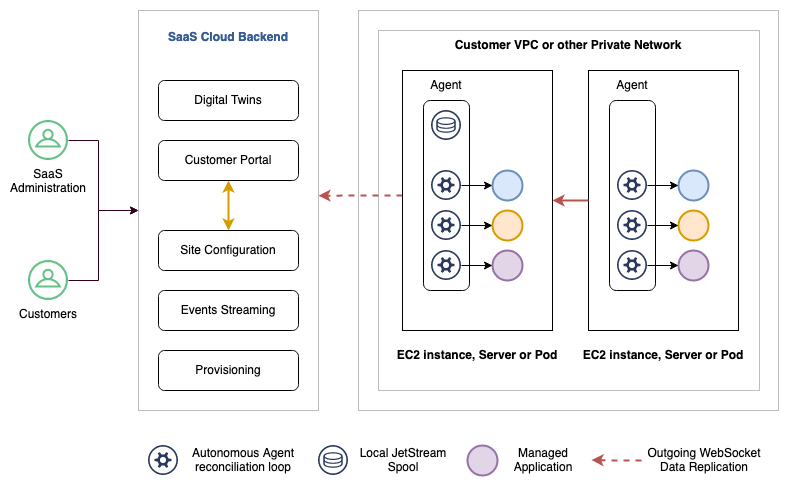Overview
This is a tool that allows automation backplanes to be built that are specifically tailored to the needs of managed SaaS software vendors.
Vendors who wish to build a SaaS offerings that allow their software to be installed and managed on private, customer owned, infrastructure can use this to build the client-side software agent quickly and easily.
This tool takes care of:
- Early provisioning of a customer into your SaaS
- Management of applications using Choria Autonomous Agents
- Data streaming, events and metrics communicated back to the SaaS using cloudevents format
- Provides various orchestration primitives for managing multi node cluster rollouts
- Over the air deployment of management control loops at runtime and at tremendous scale and performance
Using this a SaaS can go from zero to code running safely in a customer environment with less than 100 lines of code, allowing you to focus on your core business needs.
A single customer “site” can scale to 10s of thousands of nodes, and we support complex topologies and orchestration.
Example
An example speaks volumes, the code below is a complete setup of a Machine Room agent:
func main() {
app, err := machineroom.New(machineroom.Options{
Name: "example-manager",
Version: "0.0.1",
Contact: "info@example.net",
Help: "Example Manager",
// SaaS identity that verifies all plugins, ota updates and more
MachineSigningKey: "b217b9c7574.....3522da5c3b82",
})
panicIfError(err)
panicIfError(app.Run(context.Background()))
}
This code, when deployed to a customer, will:
- Read a SaaS-issued JWT holding provisioning information
- Connect to the provisioning network and enroll with the SaaS
- Restart into provisioned state:
- Start a local Choria Broker
- Create a number of local spool streams
- Set up Stream Replicator to copy data between customer and SaaS
- Regularly publish server metadata, configuration and life-cycle events
- Download Autonomous Agents from the SaaS and health check them continuously
From this point any autonomous agent actions can be used to manage software on the nodes. The SaaS can upgrade and downgrade customer sites at will.
If the customer site is offline desired state remains in the customer side and events are spooled. Once the customer is back in on-line the events will spool back to the SaaS.
Here’s output from the above main.go:
[root@managed /]# example-manager
usage: example-manager [<flags>] <command> [<args> ...]
Acme Manager
Commands:
run Runs the management agent
reset Restores the agent to factory defaults
Pass --help to see global flags applicable to this command.
And this is the agent running on a node:
[root@managed /]# ps -auxw
USER PID %CPU %MEM VSZ RSS TTY STAT START TIME COMMAND
root 1 0.2 0.1 2312836 45360 ? Ssl 12:35 0:21 /usr/bin/example-manager
Status
This is a work in progress, while we are combining existing capabilities (Broker, Server, Stream Replicator and more) into to this framework to build this capability the exact design and affordances that a tool like this should expose to the SaaS developer.
